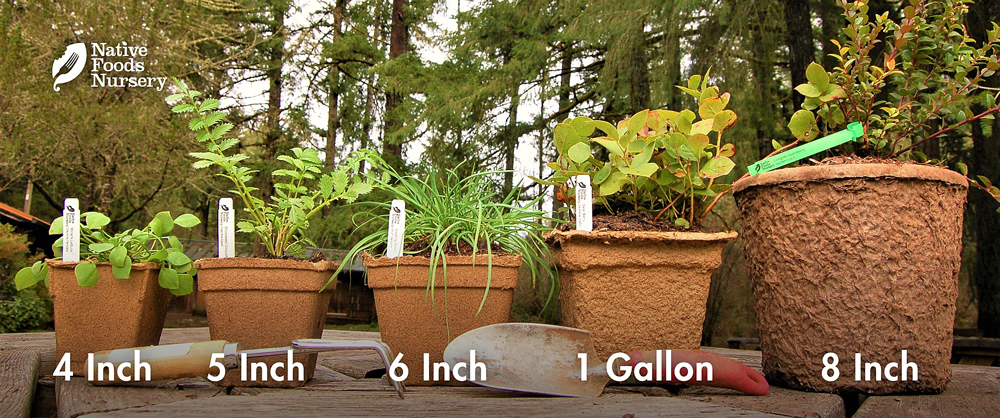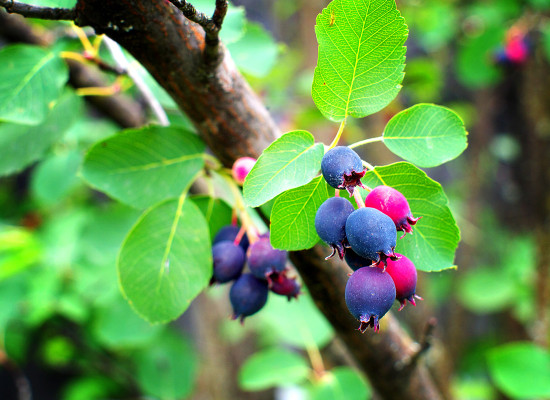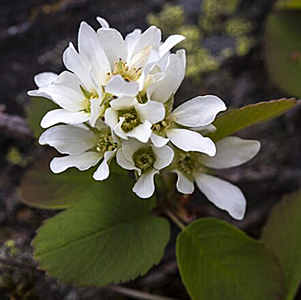Saskatoon Serviceberry - "Northline"
- Current Stock:
- 0
- Other Names:
- shadbush, shadwood or shadblow, serviceberry, sarvisberry, juneberry, saskatoon, sugarplum, wild-plum, chuckley pear
- Latin Name:
- Amelanchier alnifolia
Saskatoon Serviceberry is a medium-sized tree with gorgeous white flowers and sweet, purple-black fruits. The Northline cultivar was selected in Beaverlodge, Alberta for the superior size and flavor of its berries.
Edible Uses
It is difficult to find a book about plants native to our bioregion that does not offer effusive praise for the Saskatoon Serviceberry. Doug Benoliel in Northwest Foraging says that the fruits are “Excellent . . . raw, cooked, or dried. The flavor makes for fine pies or jams, and a handful of fresh fruit livens up a bag of granola.”
The fruits of this medium sized, deciduous shrub have and continue to be valued by Native American peoples, wild foragers, and sustainable gardeners as food wherever they were available. The excellent culinary quality of their berries makes them suitable for a wide range of uses - jams, compote, pie, dried like raisins, raw in salads, fermented into wines, beers, and ciders - use your imagination.
The fruits are a highly nutritious native food source and are rich in antioxidants, flavonoids, and polyphenols putting them in the same category as other medicinal-edible berries like Blueberry, Aronia, and Seaberry.
***NOTE: When planted in areas with the native tree Incense Cedar (Calocedrus decurrens), Serviceberries can develop a rust that can significantly reduce fruit viability. Organic fungal sprays, applied early and regularly, can reduce or eliminate the problem.
Ornamental Qualities
Serviceberry is desirable for its superior foliage, flower, and fruit. In fall the leaves turn crimson and yellow creating bright splashes of color in an evergreen landscape. Their exquisite flowers are the purest of white and clusters of the dark fruits nestle in the colorful foliage by late summer.
The Northline cultivar is usually a medium sized shrub between 5-7 feet in height. If your garden is limited by cold weather, this is the plant for you! They are hardy down to zone 2
Environment and Culture
The Serviceberry is native across a wide swath of northwestern America and Canada and extend their range all the way up to Alaska. They will provide value in your landscape grown on their own in full sun or as un understory shrub below species like Oregon White Oak, California Foothill Pine, and/or Pacific Crab Apple. It can also be paired well with smaller fruiting shrubs such as Golden Currant, Blackcap Raspberry and Salmonberry or as a canopy over groundcover like Salal or woodland Strawberry.
Saskatoon Serviceberries are also incredibly popular with the native wildlife. Their leaves and flowers are eaten by elk, deer, mice and rabbits. Pheasants, grouse, and black bears favor their berries and the winter buds are a staple food for the ruffed grouse. But don’t worry, they are prolific bearers and will provide delicious berries for you and your local wildlife.
Northwest Native American tribes today still value this special tree as food, medicine, and family. Despite great cultural losses, they continue to work towards stewarding and restoring wild populations, both strengthening the integrity of the ecology and sustaining their cultural heritage and wisdom. These strong and recovering peoples and plants deserve our respect, gratitude, and reparations. (Learn more & how to help on our Charitable Giving page.)
Harvest, Care, and Preparation
Saskatoon Serviceberries are hardy plants that only need occasional attention. However, if you're after the biggest, sweetest berries, plant them in deep, rich soil and keep them watered through the summer. They are fairly drought-tolerant once established.
Saskatoons ripen in early summer on the coast and late summer at higher elevations, but produce well in both locations. Great harvested straight off the plant on a warm August afternoon, but are even sweeter when dried. Try jams, jellies, and pies, or simply add a handful of dried or frozen berries to a glass of sparkling water for a healthy refreshing drink with a sweet aftertaste!
Native Range: CA, OR, WA, ID, BC, AK
USDA zones: 2-8
Ease of Care: Easy
Deer Resistance: Moderate
Light Requirements: Full Sun to Partial Shade
Soil Type: Tolerates most soil types, grows best in well drained soils.
Water Requirements: Moist
Pollination: Self Fertile
Bearing Age: 2-3 Years from planting
Size at Maturity: 5-7ft
Bloom Time: April-May
Harvest Time: Mid to Late Summer
Pot Sizing Guide

Our policy lasts 30 days. If 30 days have gone by since your purchase, unfortunately we can’t offer you a refund or exchange. To be eligible for a return, your item must be unused and in the same condition that you received it. It must also be in the original packaging. Gift cards are non-refundable. Once your return is received and inspected, we will send you an email to notify you that we have received your returned item. We will also notify you of the approval or rejection of your refund. If you are approved, then your refund will be processed, and a credit will automatically be applied to your credit card or original method of payment, within a certain amount of days.








